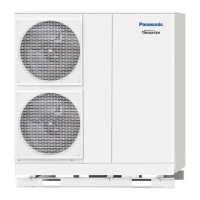20 Aquarea air-to-water heat pumps - Planning and installation manual - 02/2022
Product Description
4
4.3 Heat pump
4.3.1 Functioning and Characteristics
Panasonic has developed the heat pump, as the core of the heat pump system, in three dierent
model series. This makes it possible to oer the best possible solution to address individual heat
supply requirements for buildings:
● Aquarea High Performance
Ideal for low-consumption houses with low-temperature radiators or underoor
heating.
● Aquarea T-CAP
For applications where the nominal heating capacity must be maintained even at
outside temperatures ranging from -7 or -20 °C. Care is taken to ensure that sucient
power output is always available for heating the house, even at extremely low outside
temperatures, even without support from an additional heat source.
● Aquarea HT
For houses with traditional high temperature radiators (e.g. in refurbishment projecs),
because Aquarea HT provides supply water temperatures up to 65 °C without any
support from other heating systems, even at outside temperatures of -15 °C.
For all series - except the HT series - a cooling function can be activated. Moreover, all Aquarea
heat pump series oer the choice of either a mono-bloc system (comprising just an outdoor unit), or
a bi-bloc system (comprising an outdoor unit and a hydrokit) (→ 4.5 Model types, p. 23).
4.3.2 Operating mode
In general: The greater the dierence between the outside temperature and temperature of the
useful heat, the lower is the COP of the heat pump. As high temperature dierences seldom occur
over the course of the year on properly planned heat pump systems, brief additional re-heating
using backup heaters is often accepted. As an alternative to backup heater, you can also work with
a peak load or alternative heat source, such as a condensing boiler or a replace. Four operating
modes are distinguished as follows:
● Monovalent operating mode:
The heat pump serves as the sole heat source.
● Mono-energetic operating mode:
One type of energy (electricity) is used in various heat sources (electric heat pump +
electric heating element for peak load).
● Bivalent alternative operating mode:
As an alternative to the heat pump, a second heat source supplies the object using
another type of energy (e.g. replace instead of heat pump for outside temperatures
< -5 °C).
● Bivalent parallel operating mode:
Besides the heat pump, a second heat source is used using another type of energy.
Both heat sources are operated simultaneously (e.g. heat pump + condensing boiler
for outside temperatures < 0 °C).
!
IMPORTANT
If the heat pump in combination with an electric backup heater is operated mono-energetically, the
backup heater should cover a maximum of 15 % of the heat requirement.

